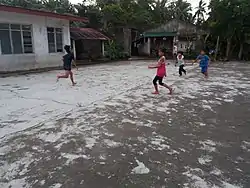Tumbang preso
Tumbang preso ("knock down the prisoner"), also known as tumba lata ("knock down the can") or bato lata ("hit the can [with a stone]"), is a traditional Filipino children's game. It is usually played in backyards, parks, or in streets when there is little traffic in an area.

Description
The equipment needed is an empty milk can or any kind of can or bottle, and a slipper or a piece of flat stone as a pamato for each player. To make the game enjoyable and exciting, there should be no more than nine players. One player or the "tayà" ( the "It") guards the milk can while the others stay behind the toe-line with their pamatose. The objective is for the players to hit and knock down the milk can with the pamato, and for the It to put back the can inside a small circle a few meters away from the toe-line. When a player is tagged while recovering their pamato, they become the It.[1][2][3][4][5]
Mechanics
The mechanics of tumbang preso are somewhat similar to Duck on a Rock:
- An It, the one to guard the tin can is chosen by throwing the pamato to the toe-line by all the players. Whoever's pamato is farthest from the toe-line is the It.
- The hitters will get ready at the back of the toe-line and at a signal from the It, game starts.
- The pamato must be retrieved immediately once the can is knocked down, the It will start putting it up inside the circle, the one tagged becomes the It.
- When the can is hit and falls outside the circle but remains standing, the It has the right to tag the hitter once the hitter leaves the toe-line.
- The can may be kicked or knocked down under when it is outside the circle.
- If a hitter is not able to retrieve his/her pamato, the others can save him/her by hitting the can.
Variation
This variation is played on narrow streets or sidewalks. The same rules apply except for some changes:
~ Two toe-line are drawn, on opposite sides and are closer to the circle.
~ The number of hitters will be divided on opposite sides.
~ The milk can may also be flattened a little to make it harder to topple. This can be done by slightly hitting the sides of the can with a blunt object until it folds, then stepping on the can carefully
~ When the hitters run out of pamato, the game turns into a chase. Players on one side will act as bait while those on the other side will try to kick the can, all while trying to avoid being tagged.
~ After the can falls down, the game is paused and all pamato is retrieved.
See also
- Traditional games in the Philippines – list of traditional Filipino children's games
- Kick the can
References
- "Having fun the Pinoy way: Bato-lata/Tumbang-preso". Ramon Aboitiz Foundation Inc. 3 October 2012. Retrieved 25 December 2016.
- AJ Martin (15 October 2011). "Ethnic Games Palooza Part 3: "Tumba Lata"". Live in the Philippines Web Magazine. Retrieved 25 December 2016.
- Crispina C. Garcia, Bella Mirasol-Elechicon, Caridad A. Arguelles, & Carmen Tabije-Andin (2005). Music, Arts and Physical Education. Rex Bookstore, Inc. p. 334. ISBN 9789712318009.CS1 maint: multiple names: authors list (link)
- Greg Nickles (2002). Philippines - The People. Crabtree Publishing Company. p. 23. ISBN 9780778793533.
- Valerie Petrillo (2007). A Kid's Guide to Asian American History: More Than 70 Activities. Chicago Review Press. p. 144. ISBN 9781613740378.